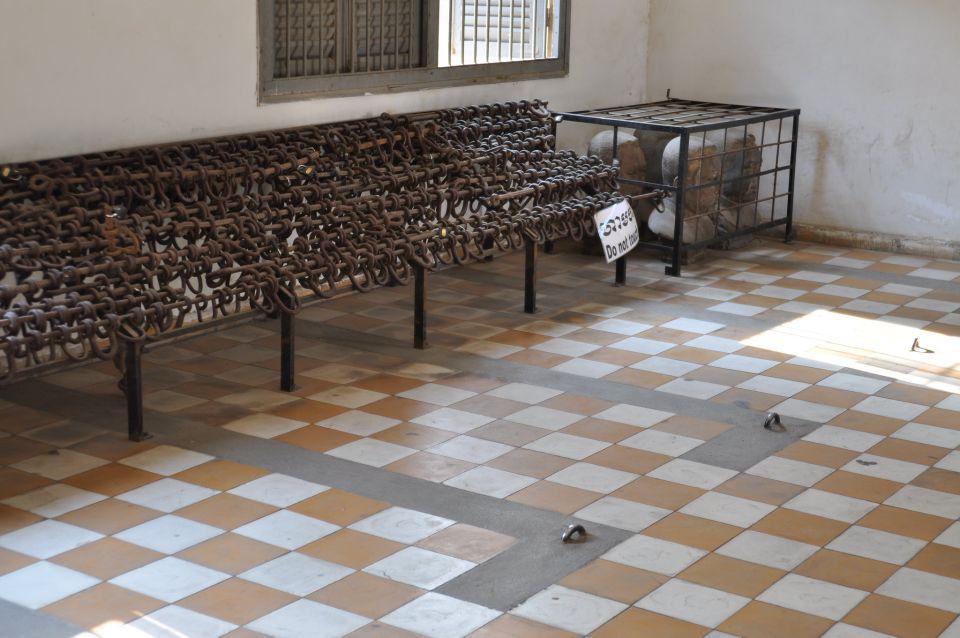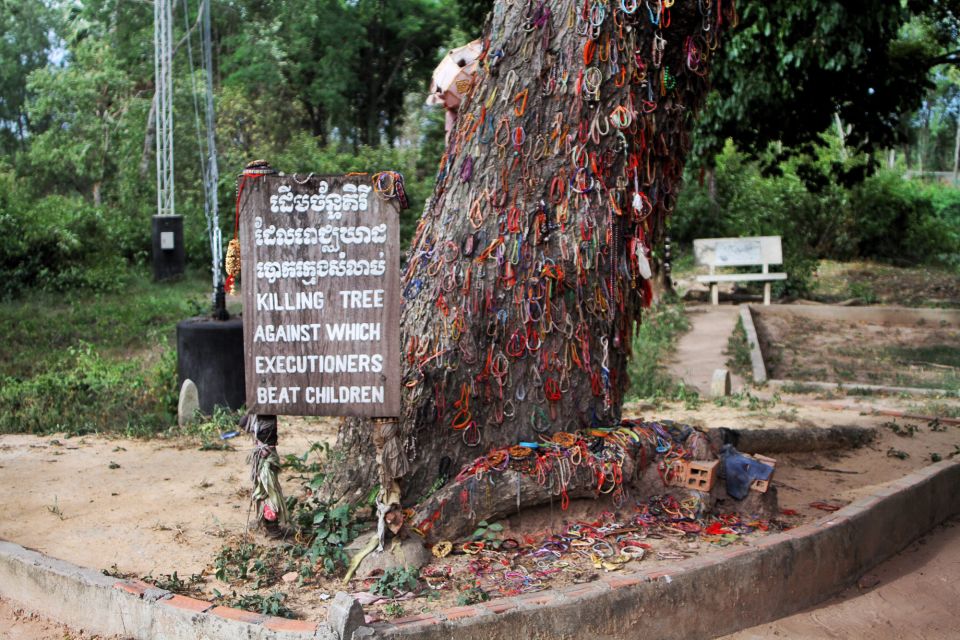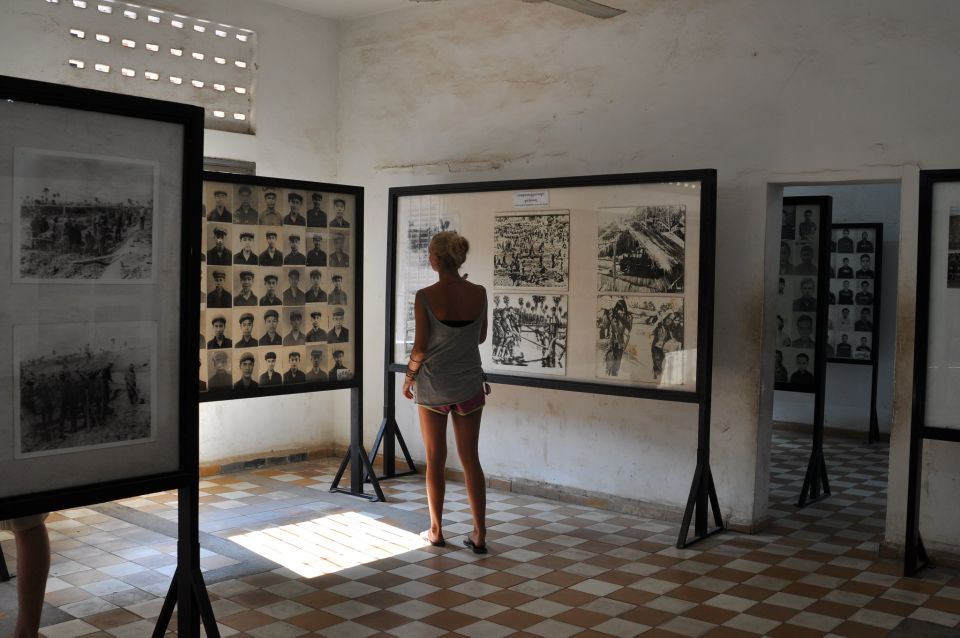Exploring the depths of Cambodia’s history through the lens of the Khmer Rouge era is nothing short of eye-opening. At the Tuol Sleng Museum, once a high school turned prison, visitors can’t help but feel the weight of the past as they walk through chilling exhibits that document unimaginable suffering. Just a short trip away, the Killing Fields serve as a haunting reminder of the lives lost. But what truly stands out is how these sites reflect the resilience of Cambodia’s people. Curious about the stories behind these memorials and what they reveal about human strength?
Good To Know

- The Khmer Rouge, led by Pol Pot, created a regime resulting in approximately 2 million deaths through violence and targeted persecution of intellectuals.
- The Tuol Sleng Museum, a former school turned prison, illustrates the horrors of the regime with survivor stories and exhibits showcasing suffering.
- S21 serves as a haunting reminder of human suffering, with preserved photographs and rooms echoing the cries of victims from its tragic history.
- The Killing Fields, located outside Phnom Penh, mark the final resting place of around 20,000 victims, with a memorial Stupa containing their skulls.
- Guided tours to these sites provide emotional insights and historical context, ensuring the memory of the victims endures and educates future generations.
Overview of the Khmer Rouge

The Khmer Rouge, known for its brutal regime in Cambodia during the late 1970s, unleashed a wave of terror that reshaped the nation’s history and left deep scars on its people.
Led by Pol Pot, this radical communist movement aimed to create an agrarian utopia, but instead, it resulted in the deaths of around 2 million Cambodians. Families were torn apart, cities were evacuated, and intellectuals became targets.
The regime’s paranoia fueled a reign of violence that turned everyday life into a nightmare. It’s hard to comprehend the sheer brutality of this period, but understanding it’s crucial for recognizing the resilience of the Cambodian people.
Their story is one of survival, and it still resonates deeply today.
You can also read our reviews of more tours and experiences in Phnom Penh.
The Tuol Sleng Museum

At Tuol Sleng Museum, visitors step into a haunting yet essential chapter of Cambodia’s history, where the remnants of a former high school turned prison tell the tragic stories of countless lives affected by the Khmer Rouge regime. The atmosphere is heavy, yet it’s a vital experience for understanding the past. Guests can explore chilling artifacts and hear the heart-wrenching tales of survivors.
| What You’ll See | Why It Matters |
|---|---|
| Prison Cells | A glimpse into survival and suffering |
| Photographs | Faces of the lost and forgotten |
| Survivor Stories | Lessons in resilience and hope |
This museum isn’t just a place to visit; it’s an emotional journey that connects the past to present and future.
Historical Significance of S21

S21, once a high school, transformed into a notorious prison, stands as a chilling reminder of the brutal realities of the Khmer Rouge regime. This place isn’t just a museum; it’s a testament to human suffering and resilience.
Visitors flock here to grasp the harrowing history of the thousands who lost their lives within its walls. Each room echoes the cries of the past, showcasing the horrific methods used during interrogations. The preserved photographs of victims personalize the tragedy, making it impossible to forget.
S21 serves as a vital educational resource, urging people to remember and learn from this dark chapter. By exploring its significance, visitors honor the victims and help ensure that such atrocities never happen again.
The Killing Fields Explained
Located just outside Phnom Penh, the Killing Fields reveal a haunting chapter of Cambodia’s history, where the grim realities of the Khmer Rouge’s reign unfold amidst serene landscapes. Visitors can’t help but feel the weight of the past as they explore this site of tragedy.
Here are three key points that make the Killing Fields unforgettable:
-
Mass Executions: This location is the final resting place for approximately 20,000 victims, showcasing the horrific scale of the atrocities.
-
Memorial Stupa: A chilling yet beautiful structure filled with the skulls of the deceased, serving as a stark reminder of the genocide.
-
Guided Tours: Knowledgeable guides share poignant stories, bringing the history to life and ensuring the memory of the victims endures.
Tour Pricing and Duration

For just £39.36 per person, travelers can embark on a 5-hour journey through Cambodia’s poignant history, exploring the haunting sites of the Tuol Sleng Museum and the Killing Fields.
This affordable price includes hotel pick-up and drop-off, plus a professional English-speaking guide to enrich the experience. It’s a great deal, especially with the flexibility of free cancellation up to 24 hours in advance—no worries if plans change!
Plus, you can reserve your spot and pay later, making it super convenient. This tour operates rain or shine, ensuring that everyone can dive into this essential chapter of history.
Travelers won’t just see the sights; they’ll connect with the stories that shaped Cambodia.
- Daily Trip Phnom Penh to Siem Reap
- Phnom Penh to Siem Reap by Private Car or Minivan
- Tuol Sleng Genocide Museum (S-21) and Choeung Ek Killing Fields Tour
- A Day Trip Sightseeing Phnom Penh – Siem Reap – Private English Speaking Driver
- Phnom Penh Morning Market & Food Tour by Tuktuk – Includes All Food & Drinks!
- Visit 11 Places in One Day Tour Including S21 & Killing Field
Itinerary and Experience

Kick off the day with a convenient hotel pick-up, setting the stage for an unforgettable journey through Cambodia’s heart-wrenching history. The itinerary is packed with insightful stops that bring the past to life.
Tuol Sleng Genocide Museum: Explore the chilling transformation of a high school into a prison and learn about the Khmer Rouge regime.
Killing Fields at Choeung Ek: Walk through the site where thousands lost their lives, gaining a deeper understanding of the atrocities committed.
Guided Experience: Enjoy a knowledgeable guide who’ll share stories and context, making the history resonate even more.
Inclusions and Transportation Options

The tour’s inclusions and transportation options ensure a comfortable and enriching experience as visitors embark on their journey through Cambodia’s poignant history.
Guests can enjoy convenient hotel pick-up and drop-off, making life a breeze. With a professional English-speaking guide leading the way, they’ll uncover the stories behind Tuol Sleng and the Killing Fields.
Transportation is flexible too—travelers can choose between a shared tuk tuk for a cozy group of three or an air-conditioned vehicle for larger groups.
Plus, everyone gets complimentary cold water, local snacks, and a short coffee break to recharge. Entrance fees are all covered, so visitors can focus on absorbing the powerful history without worrying about extra costs.
It’s an unforgettable experience!
Visitor Guidelines and Recommendations

Visitors should come prepared to embrace the profound history of Tuol Sleng Museum and the Killing Fields, ensuring a respectful and insightful experience. To make the most of their visit, they should keep a few key tips in mind:
-
Dress Respectfully: Wear comfortable, modest clothing. It shows respect for the somber nature of the sites.
-
Stay Mindful: Keep noise levels down and be considerate of other visitors. It’s a place for reflection.
-
Capture Memories: Bring a camera, but remember to ask permission before photographing people, especially in sensitive areas.
Frequently Asked Questions

What Is the Best Time to Visit the Tuol Sleng Museum and Killing Fields?
He thinks the best time to visit’s early morning or late afternoon. The cooler temperatures make it more comfortable, plus the light’s perfect for photos, capturing the haunting beauty of the sites.
Are There Age Restrictions for Visiting These Historical Sites?
Heard there’s no strict age limit for visiting those historical sites, but parents should consider the content’s intensity. It’s definitely a profound experience, so older kids and teens might get the most out of it!
Is Photography Allowed Inside the Museum and at the Killing Fields?
Photography’s allowed inside the museum and at the Killing Fields, but visitors should respect the solemnity of the sites. Capturing memories is great, but it’s essential to maintain a respectful atmosphere while doing so!
Can I Visit Both Sites Independently Without a Guided Tour?
Absolutely! They can explore both sites independently without a guided tour. It’s a unique experience, letting them soak in the history at their own pace. Just remember to respect the solemn atmosphere and significance!
What Is the Dress Code When Visiting These Memorial Sites?
When visiting these memorial sites, he knows it’s best to dress respectfully. Comfortable, casual attire works great, but avoiding revealing clothing shows consideration for the somber nature of the places. It’s all about respect!
The Sum Up
Visiting the Tuol Sleng Museum and the Killing Fields is a powerful journey into Cambodia’s past that leaves a lasting impression.
These sites not only educate visitors about the horrors of the Khmer Rouge era but also showcase the incredible resilience of the Cambodian people.
It’s an emotional experience that sparks reflection and understanding.
So, if you’re in Phnom Penh, don’t miss out on these poignant reminders of history—they’re eye-opening and truly unforgettable!
You can check availability for your dates here:More Museum Experiences in Phnom Penh
- Killing Fields and Toul Sleng S21 Museum Half-Day Tours
- Phnom Penh :S21 Tuol Sleng Museum & Killing Field with Lunch
- Half Day Trip to S21 Prison Genocidal Museum & Killing Field
- Phnom Penh: killing field & Toul Sleng genocide museum Tour
- Phnom Penh: Killing Fields and S21 Genocide Museum Tour
- Phnom Penh: Killing Fields and S21 Genocide Museum Tour
More Tour Reviews in Phnom Penh
- Sunset Cruise: Your Cruise You Choose, 3 wonderful options
- Visiting 9 Places in 3 hours Tour by Tuk-Tuk in the Evening
- Scenic Phnom Penh to Siem Reap Transfer with Sightseeing
- Phnom Penh: Full-Day City Tour with Experienced Tour Guide
- Phnom Penh: Private Tuk-Tuk Tour with English-Speaking
- Phnom Penh: Nightlife Hidden Local Bars Tour
Not for you? Here's more nearby things to do in Phnom Penh we have reviewed
- Sunset Cruise: Your Cruise You Choose, 3 wonderful options
- Visiting 9 Places in 3 hours Tour by Tuk-Tuk in the Evening
- Scenic Phnom Penh to Siem Reap Transfer with Sightseeing
- Phnom Penh: Full-Day City Tour with Experienced Tour Guide
- Phnom Penh: Private Tuk-Tuk Tour with English-Speaking
- Phnom Penh: Nightlife Hidden Local Bars Tour
- Phnom Penh: Sunset Cruise with Unlimited Beers & BBQ Buffet
- Kulen Waterfall: Rise and Shine with Cliff, Village w/ Guide
- Killing Fields and Toul Sleng S21 Museum Half-Day Tours
- Phnom Phnom: Local Market & Culture Walking of City Tour
- Phnom Penh: Full-Day City Tour with Royal Palace & Killing
- Phnom Penh: Royal Palace, S21, Killing Fields & More Tour
